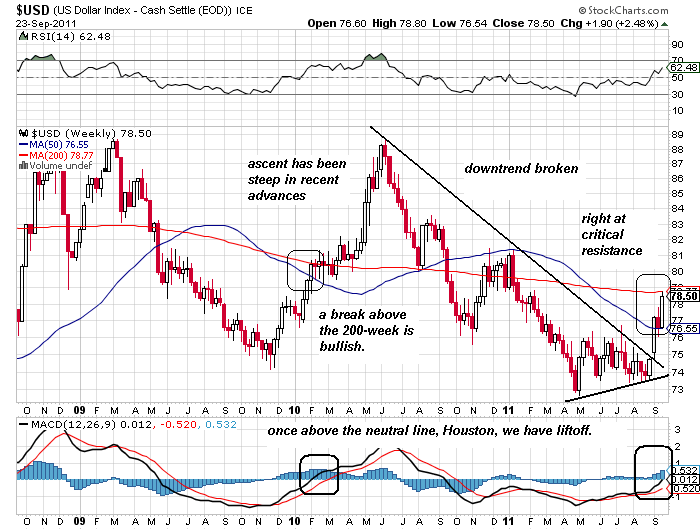The U.S. Dollar, Technically Speaking
Technical traders don't pay attention to explanations of what should happen or is not possible; they just look at the action of price and indicators. For the past several years, the dominant view of the U.S. dollar has been that a sustained rise in the dollar is not possible. This offers a good example of the difference between "fundamental" explanations and predictions of financial trends, and the technical perspective. Fundamental explanations and predictions have an awkward tendency to claim something that has already happened is impossible. Technical traders avoid fundamental explanations about why some trend or another is impossible or inevitable. These explanations tend to be highly appealing ideologically, but ideology of any flavor generally makes a poor foundation for making productive trades. With that preface, let's look at a weekly chart of the long-loathed U.S. dollar: While there are compelling fundamental explanations of why the U.D. dollar is doomed in the long run, making money in the present via predicting what might happen in future years is intrinsically problematic because nobody knows what will happen in the future, or when. Traders can only make money by assessing the probabilities of near-term price movement based on price and reflections of price movement, i.e. indicators. For example, if you call up a long-term chart of the Dow Jones Industrial Average (DJIA), you will note that the 20-week moving average fell below the 50-week moving average (MA) in February 2008. This bearish cross presaged the meltdown that ensued later that year. Now we see the exact same cross occurring in September 2011. Coincidence? Possibly. After all, isn't the DJIA up big today? In a similar fashion, the 50-day MA is about to make a bullish cross up through the 200-day MA on the DXY (dollar index). A sign of strength? If an investor's ideology demands a bearish intepretation to all data regarding the dollar, then anything that runs counter to that ideology must be rejected. On this weekly chart of the DXY, we observe price has broken a long downtrend, and that it has risen above the 50-week MA and is now testing strong resistance at the 200-week MA. By happenstance (or not), the DJIA is struggling to stay above its 200-week MA at 10,730. In the past, when the DXY broke above the 200-week MA, a powerful uptrend developed. Interestingly, skepticism is the ideal background for a sustained rally because skeptics resist buying in, creating a large pool of potential future buyers. Is a sustained uptrend in the U.S. dollar possible or impossible? Technically, nobody can say. All a technical trader can assess is what looks more or less probable near-term, given past technical signals and price action. If this recession strikes you as different from previous downturns, you might be interested in my new book An Unconventional Guide to Investing in Troubled Times (print edition) or Kindle ebook format. You can read the ebook on any computer, smart phone, iPad, etc.Click here for links to Kindle apps and Chapter One. The solution in one word: Localism. Order Survival+: Structuring Prosperity for Yourself and the Nation (free bits) (Mobi ebook) (Kindle) or Survival+ The Primer (Kindle) or Weblogs & New Media: Marketing in Crisis (free bits) (Kindle) or from your local bookseller. Of Two Minds Kindle edition: Of Two Minds blog-Kindle
Readers forum: DailyJava.net.
My new book An Unconventional Guide to Investing in Troubled Times is available in Kindle ebook format. You can read the ebook now on any computer, smart phone, iPad, etc. Click here for more info about Kindle apps and the book.Thank you, John F. ($10/mo), for your splendidly generous subscription to this site -- I am greatly honored by your support and readership. Thank you, Gerard L. ($50), for your magnificently generous contribution to this site -- I am greatly honored by your ongoing support and readership.




























